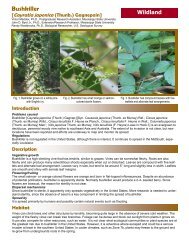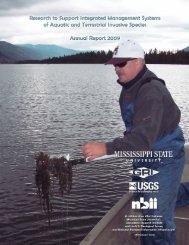Assessment of Herbicide Efficacy on Eurasian Watermilfoil and ...
Assessment of Herbicide Efficacy on Eurasian Watermilfoil and ...
Assessment of Herbicide Efficacy on Eurasian Watermilfoil and ...
Create successful ePaper yourself
Turn your PDF publications into a flip-book with our unique Google optimized e-Paper software.
Key words:<br />
2,4-D, Myriophyllum spicatum,<br />
Navigate, point intercept,<br />
Renovate3®, species richness, triclopyr.<br />
6<br />
INTRODUCTION<br />
Hayden Lake is located in northern Idaho <strong>and</strong> has been<br />
invaded <strong>and</strong> col<strong>on</strong>ized by <strong>Eurasian</strong> watermilfoil ( Myriophyllum<br />
spicatum L.) in the past decade. <strong>Eurasian</strong> watermilfoil was<br />
first identified in Hayden Lake in 1998 by the Kootenai<br />
County Noxious Weed Program, prompting an operati<strong>on</strong>al<br />
c<strong>on</strong>trol program beginning in 1999. During the 1998-1999<br />
growing seas<strong>on</strong> there was approximately 243 ha (600 ac) <str<strong>on</strong>g>of</str<strong>on</strong>g><br />
<strong>Eurasian</strong> watermilfoil, which represented roughly 16% <str<strong>on</strong>g>of</str<strong>on</strong>g> the<br />
total surface area <str<strong>on</strong>g>of</str<strong>on</strong>g> Hayden Lake. The initial introducti<strong>on</strong>,<br />
spread, <strong>and</strong> possible reintroducti<strong>on</strong> <str<strong>on</strong>g>of</str<strong>on</strong>g> <strong>Eurasian</strong> watermilfoil<br />
is likely attributed to increased disturbance within the lake<br />
<strong>and</strong> watershed <str<strong>on</strong>g>of</str<strong>on</strong>g> Hayden Lake. The shoreline <str<strong>on</strong>g>of</str<strong>on</strong>g> Hayden<br />
Lake is becoming suburbanized with increases in houses,<br />
parks, beaches, <strong>and</strong> impermeable surfaces. This development<br />
results in greater run<str<strong>on</strong>g>of</str<strong>on</strong>g>f into the lake <strong>and</strong> greater use<br />
<str<strong>on</strong>g>of</str<strong>on</strong>g> the lake for recreati<strong>on</strong> (Hayden Lake Watershed Associati<strong>on</strong><br />
2008). As lake shores become more developed <strong>and</strong> recreati<strong>on</strong><br />
<strong>on</strong> the water increases, the level <str<strong>on</strong>g>of</str<strong>on</strong>g> disturbance also<br />
increases, which may result in reducti<strong>on</strong>s in native species.<br />
Removal or reducti<strong>on</strong>s in native species opens a niche for<br />
fast-growing col<strong>on</strong>izing species like <strong>Eurasian</strong> watermilfoil<br />
(Davies et al. 2005, Lockwood et al. 2005, Capers et al. 2007).<br />
Also, in recent years, a growing tourist industry has attracted<br />
an estimated 800,000 people each year to the regi<strong>on</strong> (Hayden<br />
Lake Watershed Associati<strong>on</strong> 2008), further putting the<br />
lake at risk to potential invasi<strong>on</strong> by n<strong>on</strong>-native species.<br />
The threats posed by <strong>Eurasian</strong> watermilfoil to Hayden<br />
Lake <strong>and</strong> other water bodies in the state have prompted the<br />
Idaho State Department <str<strong>on</strong>g>of</str<strong>on</strong>g> Agriculture (ISDA), in cooperati<strong>on</strong><br />
with the Idaho Invasive Species Council, to develop a<br />
<strong>Eurasian</strong> watermilfoil eradicati<strong>on</strong> program (ISDA 2007). As<br />
part <str<strong>on</strong>g>of</str<strong>on</strong>g> this program, suspected waterbodies are being m<strong>on</strong>itored<br />
to detect the presence <str<strong>on</strong>g>of</str<strong>on</strong>g> <strong>Eurasian</strong> watermilfoil, <strong>and</strong><br />
those already infested are being m<strong>on</strong>itored to document the<br />
extent <strong>and</strong> spread <str<strong>on</strong>g>of</str<strong>on</strong>g> <strong>Eurasian</strong> watermilfoil. The point-intercept<br />
method was chosen as the sampling protocol for the<br />
program due to the simplicity <str<strong>on</strong>g>of</str<strong>on</strong>g> data collecti<strong>on</strong> <strong>and</strong> the ability<br />
to c<strong>on</strong>duct a quantitative statistical assessment <str<strong>on</strong>g>of</str<strong>on</strong>g> plant<br />
c<strong>on</strong>trol techniques.<br />
Management <str<strong>on</strong>g>of</str<strong>on</strong>g> <strong>Eurasian</strong> watermilfoil from 1999 to 2009 in<br />
Hayden Lake included the use <str<strong>on</strong>g>of</str<strong>on</strong>g> herbicides, diver-operated<br />
sucti<strong>on</strong> dredging, <strong>and</strong> bottom barriers. Over the past 10 years,<br />
583 ha (1441 ac) <str<strong>on</strong>g>of</str<strong>on</strong>g> <strong>Eurasian</strong> watermilfoil has been managed<br />
-1<br />
-1<br />
at an average cost <str<strong>on</strong>g>of</str<strong>on</strong>g> $2074 ha ($838 acre ; Inl<strong>and</strong> Empire Cooperative<br />
Weed Management Area, unpublished data). In<br />
2007, the auxin-mimicking herbicides triclopyr (triethylamine<br />
(TEA) salt <str<strong>on</strong>g>of</str<strong>on</strong>g> [(3,5,6-trichloro-2-pyridinyl) oxy]acetic acid)<br />
<strong>and</strong> 2,4-D (Butoxyethyl ester <str<strong>on</strong>g>of</str<strong>on</strong>g> (2,4-dichlorophenoxy) acetic<br />
acid) were selected for c<strong>on</strong>trolling <strong>Eurasian</strong> watermilfoil in<br />
Hayden Lake. Triclopyr <strong>and</strong> 2,4-D have been used in smallplot<br />
<strong>and</strong> whole-lake management programs to c<strong>on</strong>trol <strong>Eurasian</strong><br />
watermilfoil <strong>and</strong> in many instances have shown c<strong>on</strong>siderable<br />
selectively in removing <strong>Eurasian</strong> watermilfoil with little to<br />
no impact <strong>on</strong> native plant communities (Getsinger et al. 1982,<br />
1997, 2000, Pars<strong>on</strong>s et al. 2001, Poovey et al. 2004).<br />
While much is known about the use patterns <str<strong>on</strong>g>of</str<strong>on</strong>g> 2,4-D <strong>and</strong><br />
triclopyr <strong>on</strong> an anecdotal basis, there are relatively few published<br />
accounts <str<strong>on</strong>g>of</str<strong>on</strong>g> case studies using these products. The objectives<br />
<str<strong>on</strong>g>of</str<strong>on</strong>g> this study were to (1) c<strong>on</strong>duct early <strong>and</strong> late<br />
seas<strong>on</strong> surveys <str<strong>on</strong>g>of</str<strong>on</strong>g> the littoral z<strong>on</strong>e <str<strong>on</strong>g>of</str<strong>on</strong>g> Hayden Lake to assess<br />
the current plant community <strong>and</strong> (2) c<strong>on</strong>duct pre- <strong>and</strong> postherbicide<br />
treatment surveys to assess the level <str<strong>on</strong>g>of</str<strong>on</strong>g> c<strong>on</strong>trol <str<strong>on</strong>g>of</str<strong>on</strong>g><br />
<strong>Eurasian</strong> watermilfoil <strong>and</strong> impacts <strong>on</strong> n<strong>on</strong>target native plant<br />
species throughout the lake where treatments using triclopyr<br />
<strong>and</strong> 2,4-D were performed.<br />
Study Site<br />
MATERIALS AND METHODS<br />
Hayden Lake (47°46’1.167”N; 116°42’24.165”W) is located<br />
in northern Idaho <strong>and</strong> is approximately 1568 ha in total<br />
area. Hayden Lake has a maximum depth <str<strong>on</strong>g>of</str<strong>on</strong>g> 54 m <strong>and</strong> mean<br />
depth <str<strong>on</strong>g>of</str<strong>on</strong>g> 28 m (Bellatty 1990). The major l<strong>and</strong> use surrounding<br />
the lake is agriculture <strong>and</strong> grazing. There are approximately<br />
43 km <str<strong>on</strong>g>of</str<strong>on</strong>g> shoreline, <str<strong>on</strong>g>of</str<strong>on</strong>g> which more than 85% is<br />
developed (Bellatty 1990). The primary uses <str<strong>on</strong>g>of</str<strong>on</strong>g> the lake are<br />
recreati<strong>on</strong>al including boating, skiing, <strong>and</strong> fishing. Hayden<br />
Lake is oligotrophic with water clarity (Secchi depths) exceeding<br />
7 m, <strong>and</strong> the lake is c<strong>on</strong>sidered to be nutrient poor<br />
with total nitrogen (NO2<br />
+ NO3)<br />




